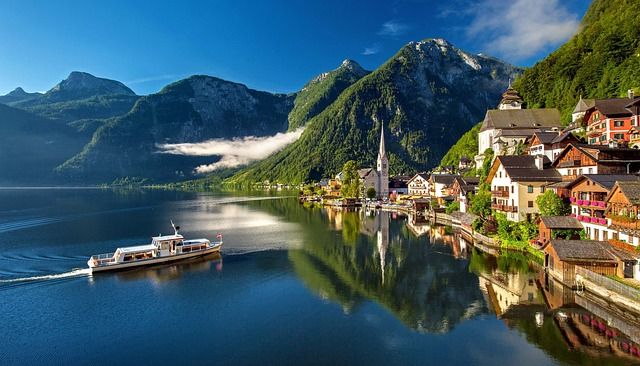
pc:pixabay.com
This week we traveled to the country where some say classical music was born: Austria! Have a Viennese ball browsing our playlist of Austrian composers, from the Salzburg celebrity to the Third Man.
Johann Strauss, Jr. (1825-1899) An der schönen, blauen Donau [The Blue Danube], Op. 314 The beautiful, blue Danube River, one of the longest rivers in Europe, flows through the city of Vienna, where Johann Strauss Jr. made his name as the “Waltz King” in the late 19th century. While “The Blue Danube” waltz has certainly become one of, if not the most famous waltz by Strauss, it began as humble filler music that Strauss happened to have on hand at a dance. Strauss thought the tune wasn’t catchy enough and yet, after the first performance, he received requests to conduct the work at an upcoming concert! That went over so well that lyrics were set to the melody, and a choral version was premiered by the Viennese Men’s Choral Association. The enduring popularity of this waltz is also due to its use in Austria as an unofficial New Year’s anthem. It plays on TV at midnight, and is a traditional encore on the Vienna Philharmonic’s New Year’s day concert.
Wolfgang Amadeus Mozart (1756-1791) The Abduction from the Seraglio: Act 1. Chorus of the Janissaries In the late 18th century, the Viennese court decided to sponsor a project with local theaters to produce operas in the German language. While the project turned out to be a failure, it was able to produce a few great successes, including Mozart’s The Abduction from the Seraglio. Set in a Turkish harem, Mozart knew that Viennese audiences were drawn to the perceived exoticism of the Ottoman Turks whom Austria had warred with for centuries. The first act of the opera is set in the country palace of a Turkish Pasha named Osmin. In Turkish culture, a Pasha's political status was similar to that of a governor or knight. Mozart's audience would have associated the seraglio or harem in Pasha Osman's palace with a kind of exotic, forbidden female sexuality. In reality, the harems of Ottoman palaces originated as the private living spaces for upper class Muslim women and their royal courts.
Anton Karas (1906-1985) The Third Man Theme Released in 1949, The Third Man is one of those rare films where the soundtrack was as critically acclaimed as the film itself. An atmospheric noir crime drama set in post-war Vienna, The Third Man’s dutch angles and harshly lit scenes of seedy locations are evocatively contrasted with the film score, which was composed and recorded entirely by one man, the zither player Anton Karas. Karas was a native Viennese professional musician, who had spent most of his career playing the Viennese concert zither in restaurants. Karas met film director Carol Reed by chance in 1948, when the director observed Karas playing in one of Vienna’s many heurigen, or wine taverns. The director was dissatisfied with the heavily orchestrated score being prepared for The Third Man and was fascinated by the subtle and simple melancholy in Karas’ zither music. He brought Karas to London, where the score was recorded in six weeks. The international success of The Third Man skyrocketed Anton Karas to stardom, who had until then been completely unknown outside of Vienna. The film score also renewed interest in zither music, especially in American cities with large populations of Austrian and German immigrants.
Franz von Suppé (1819-1895) Fair Galatea: Overture Von Suppé is the earliest Viennese composer of musical farces whose works still survive as viable stage scores. Though we know him mainly for his overtures, in his day he earned his reputation by writing operettas influenced by the rising popularity of Offenbach’s mythological satires. Fair Galatea falls squarely in this camp, where the well-known Pygmalion myth is turned into an amorous romp of coquettetry, and the living statue Galatea is actually turned back to stone at the end, due to her intense devil-may-care attitude towards love and life. As usual, the mythological figures are thinly-veiled caricatures of contemporary society. The operetta itself is also a pastiche of artforms, mixing Viennese folk theater with commedia dell'arte stock characters and opera bouffe.
Anton von Webern (1883-1945) Piano Quintet Webern was a member of the so-called Second Viennese School, and he was the most angular, pointillistic, and atonal of that lot. However before Webern became a proponent of the 12-tone serial techniques of Arnold Schoenberg, he studied the music of more traditional composers. His piano quintet was written during his formal studies of harmony, counterpoint, and musicology at the University of Vienna, and only hints at the intense experimentalism he would later commit to, abandoning all tonality for good. As far as quintets go, his Piano Quintet is a relatively short piece. This can be said for most of Webern’s compositions. His complete works can be performed in under four hours. Webern’s brevity is due, not just to his untimely death at 61 when he was accidentally shot by an American soldier in the aftermath of WW2. He preferred to write short, emotionally concentrated music.
Alma Mahler (1879-1964) Die stille Stadt [The silent town] Alma Schindler married Mahler in 1902. She grew up in an artistic family, being the daughter of the famous landscape painter Emil Schindler. She played piano from childhood and was encouraged to study composition. Her mother's second marriage to the painter Carl Moll brought her in close contact with the Viennese Secession, a modernist art movement closely related to Art Nouveau. This connection would put Mahler in contact with many modern Viennese composers, and gave her the opportunity to present chamber music at a Secession exhibition in 1902. Alma had her own aspirations as a composer that her husband unfortunately did not support, this would be one of many problems in their relationship. However he would come to regret this and later helped edit and publish five songs she wrote for voice and piano. 17 songs by her survive, 14 of which were published, though it is known she also composed chamber music and a scene for an opera.
Johann Joseph Fux (1660-1741) Concentus Musico Instrumentalis: Suite No. 6 The venerable trove of successful composers who came from Austria is commonly opened with Haydn and Mozart, but Austria produced influential musicians and composers many years before their birth. This was in part due to the Hapsbergs, the ruling family of the Austria-Hungarian empire, who were, as a whole, generous patrons and supportive of the arts. Leopard I, who ruled for the 2nd half of the 17th century even wrote his own oratorios and dance suites. He was also the employer of Johann Joseph Fux. A composer from the Austrian city of Graz, who, though he wrote beautiful music as we just heard, is mostly remembered for his Gradus ad Parnassum, a pedagogical book on counterpoint that was studied by Haydn, Mozart, Beethoven, and many others. Fux began what became a tradition in 18th century Austrian classical music: borrowing from the Italian style. The basis of his musical treatise was the music of Palestrina.
Georg Christoph Wagenseil (1715-1777) Symphony in B-Flat Major, WV 441: I. Vivace For our super stumper, we decided to play a symphony by one of Fux’s most successful students. Wagenseil was a gifted harpsichordist, and studied keyboard with Fux for 3 years until he was appointed the official composer and keyboard instructor for the Viennese imperial court in 1739, a position he held his entire life. Prolific publication of his instrumental music laid the groundwork for the development of the Viennese Classical style. His harpsichord concertos were particularly suited for young players, and it is reported that a young Mozart performed one of his concertos for Empress Maria Theresa in 1762. Wagenseil’s symphonic music is praised for its diverse influences, where the composer incorporated elements from opera in unique and charming ways.
Johann "Hans" Hölzel (1957-1998) Rock Me Amadeus By the 1980s, Austrian New Wave singer and musician Hans Hölzel was massively popular in Germany and throughout Europe. Under his stage name “Falco,” his fame spilled across the Atlantic with 1986’s Rock Me Amadeus, which hit number one on the Hot 100 Billboard charts and remains the only mostly German language song to do so. The track is a hagiographic summary of Austria’s greatest music celebrity, Mozart, recounting his infamy, celebrity and his identity as a punk in Falco’s eyes, who was inspired to compose the song after watching the 1984 film Amadeus. Released as a single and on Falco’s 3rd album, multiple edits of Rock me Amadeus were produced, including an eight minute version called the Salieri Version which featured voiceover with more historical details about Mozart, and some English translation. This longer edit gave Falco his number one spot on the US charts, and did the same in the UK, Canada, and of course, Austria.








